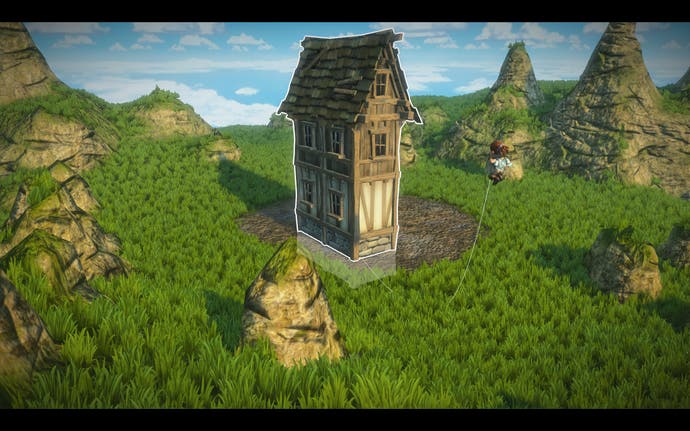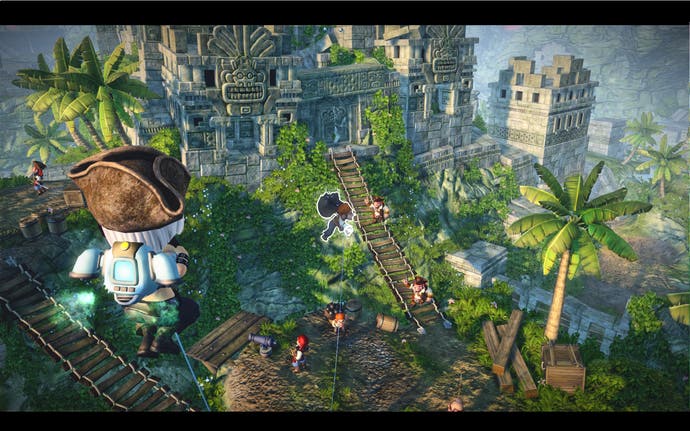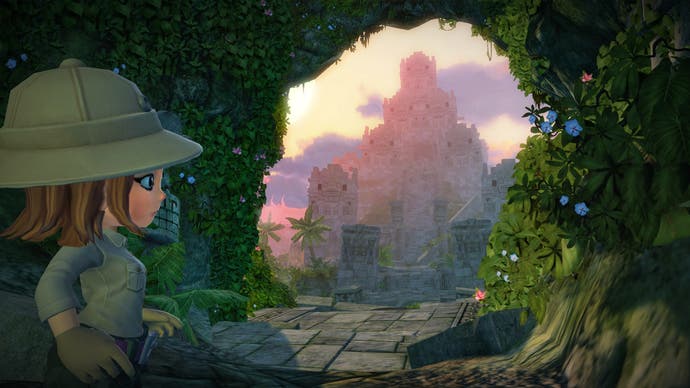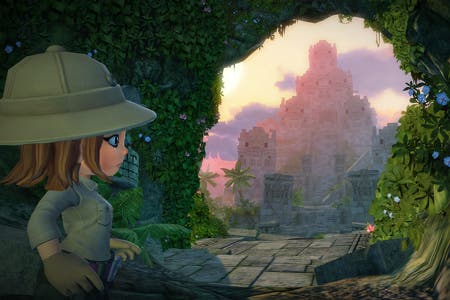Gameglobe Preview: Playful Creation from the Land of Lego
Can a bunch of triple-A console game veterans take on Sackboy with a free-to-play game?
Sometimes it feels like everyone has a game inside them: some vision they would have already made if it wasn't for a lack of spare time, money, programming skill or motivation. It's a desire so widespread that it made LittleBigPlanet a hit even though many buyers struggled to make even one basic level.
Then there's people like me, those who lack not just the technical know-how but also just the vaguest idea of what game they would make. My game-making began and ended with dismal experiments in BASIC that peaked with a terrible Afterburner rehash that didn't even feature enemies or bullets and boasted simply the arse of a plane flying ever onwards over a landscape of jerky icebergs.
So when Hapti.co, Square Enix's new Danish studio, sat me down in front of its ambitious game-making platform Gameglobe the fear set in. Alarm bells rang in my head. Ideas? Any ideas? Anything? Oh God my mind's gone completely blank. Shit. Shit. Shit.

An hour earlier game director Rune Vendler had set out the goal behind Gameglobe, which started life back when he and much of the Hapti.co team were still at Square Enix's other Copenhagen outpost IO Interactive, making triple-A games like Hitman and Kane & Lynch. The idea was to make a browser-based platform similar to Flickr where players could create and share games using a tool so simple that almost anyone could do it. Even someone like me.
While it embraces LittleBigPlanet's idea of giving creators an avatar that acts as the conduit for their game-building desires, Gameglobe is simpler to use and seems to have done so without compromising on what it can let players do. The demonstration games created by the team include reconstructions of Copenhagen's Tivoli Gardens complete with funfair rides, old school 2D shooters, a non-interactive cut scene with Final Fantasy influenced airships and 45-minute long 3D action adventures that bring Tomb Raider to mind. All made with a tool that demands little more than the ability to turn on a computer, load up a browser and search for something on Google.
"The idea is people don't need to learn," explains Vendler. "Anyone who can use a mouse can use Gameglobe: no single operation is advanced and we never ask players to use more than a single button. People dream of making games and we're helping people make those dreams come true."

To underline this point Vendler leisurely moulds a level from a bare disc of sand to functioning third-person action adventure in less than 30 minutes. With swishes of the mouse he raises and reshapes mountains before carving out tunnels and rivers as if playing Populous. He follows this by spray painting the landscape in textures that bring the land to life, opting to paint a mountain in Swiss cheese before switching it back to rock with a simple drag and drop action.
A couple of clicks later Vendler has dropped a riverside building into the world, which he then enhances by slamming other types of building into it to form a higgledy-piggledy yet believable house with jutting extensions and a working water wheel.
A quick press of F10 flips Gameglobe into playtest mode so Vendler can use his child-like avatar to test the level, making sure the distance players must jump to get from one side of the river to the other is possible. To round everything off he blocks a path with a giant wooden door that's hooked up to a switch using an invisible power cable, and then he plants a gang of pirates behind it who have their AI reactions set to attack players on sight. All of this done with just a smattering of effortless mouse movements, clicks and the occasional press on the keyboard.
It's taken less time than an episode of EastEnders to spawn a functioning game that looks and sounds surprisingly close to a short section of LEGO Pirates of the Caribbean. It might not be an award-winning creation but the speed and simplicity involved in making it is impressive.

But having the tools to create is one thing and having the imagination needed to create is another entirely. Thankfully when we sat in front of the beta version it quickly becomes clear that Gameglobe hits the same sweet spot as LEGO by making creation not just easy but fun in itself. As I looked blankly at the screen hunting for an idea, the Hapti.co staffer on hand suggested I just doodle. After 10 minutes of pleasant doodling the result was a mishmash of half-baked ideas: a mountain floating in the air; a swarm of cowardly bats in a ravine; and a deep pool of piranha-filled water.
And soon ideas began to bubble up. Maybe there could be a door in the floating mountain that linked to the one that I randomly stuck on the shipwreck that I half-buried in the dusty dunes below. There still wasn't much of a direction, though it wasn't hard to imagine that with more time something more game-like might emerge through experimentation alone. And besides, it didn't really matter because Gameglobe had made creating enjoyable enough to find pleasure in just messing around to see where it leads.
There are limitations though. At present people can not work together on creations and there are plenty of unknowns about its freemium model. Gameglobe will be free to play and players won't even need an account but accessing extra items to use when creating levels will require the spending of in-game currency that can either be earned by creating popular levels or playing other people's work or by handing over real money. Finding that delicate balance between making Gameglobe a viable business without resorting to the gaming equivalent of chugging is crucial and getting it wrong could torpedo the whole project.

Other questions also remain. Who will own the rights to what is created in Gameglobe: Square Enix, co-publisher Bigpoint or the individual creators? And can Hapti.co produce enough new objects fast enough to feed the demand of those who are creating games on the platform? The latter question is particularly important given that Hapti.co has rejected the idea of letting people import their own artwork or sounds into Gameglobe on the grounds that it will be a better experience by not allowing a content free for all.
"A lot of people have asked 'can I upload my own textures' but they also say that when they build something they are always surprised at how nice it looks," says lead programmer Peter Andreasen. "It's hard to break it to them but that's in part because it is professional people who did the textures. Our textures and sounds are made to mesh nicely together so that when you intersect objects it will look natural and nice. That's a large part of the attraction for people in the build mode. If you let them upload their own textures or MP3s then it would actually break some of the magic of being able to create something that is really beautiful."
But Hapti.co is under no illusion that, in stark contrast, to the boxed games they worked on at IO Interactive, Gameglobe will be an on-going service demanding constant refinement and improvement rather than a one-off product. "I think once it's out there it is going to be a collaboration between us and all the users and that's really exciting but it's also a little bit scary," says Vendler. "But good scary. I want to see what happens."

